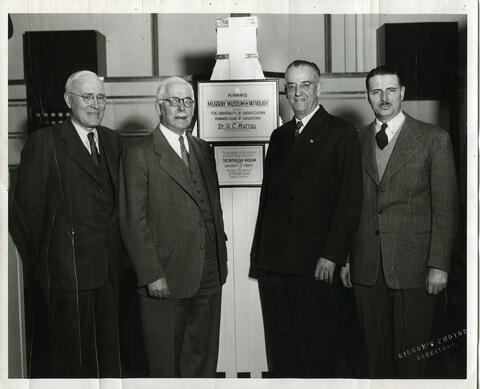
Title and statement of responsibility area
Title proper
Murray Museum of Pathology
General material designation
- Graphic material
Parallel title
Other title information
Title statements of responsibility
Title notes
Level of description
Item
Reference code
Edition area
Edition statement
Edition statement of responsibility
Class of material specific details area
Statement of scale (cartographic)
Statement of projection (cartographic)
Statement of coordinates (cartographic)
Statement of scale (architectural)
Issuing jurisdiction and denomination (philatelic)
Dates of creation area
Date(s)
-
1950 (Creation)
Physical description area
Physical description
1 photograph : b&w ; 20.32 x 25.4 cm
Publisher's series area
Title proper of publisher's series
Parallel titles of publisher's series
Other title information of publisher's series
Statement of responsibility relating to publisher's series
Numbering within publisher's series
Note on publisher's series
Archival description area
Name of creator
Custodial history
Scope and content
John W. Adams (Professor of Pathology), Dr. Caldwell (Saskatoon physician), Dr. Stewart Lindsay (Dean of Medicine) and A.M. Blue (Kiwanis Club) standing inside the Murray Museum of Pathology with a group of physicians who are members of the Kiwanis Club. "Murray Museum of Pathology".
Bio/Historical Note: It was hailed as “a progressive aid in the teaching of medicine” and consisted of 2,000 “photographic reproductions of all the organs, blood vessels, tissue and other parts of the human body showing the development of all the diseases and ailments that beset the human frame.” The black and white photos were the work of Dr. John W. Adams, assistant professor of Pathology, who shot specimens in the collection of the University of Toronto. The project was funded by the Saskatoon Kiwanis Club to the tune of $5,000 and named in memory of Dr. Walter Murray, the first president of the University of Saskatchewan. Dean Lindsay saw the museum as “a wonderful aid in the teaching of medicine.” He also saw an advantage of photos over specimens because images would not deteriorate over time. He predicted that the collection would still be useful to students in 50 years. At some point the museum became redundant and the photos and the memorial plaque vanished.
Notes area
Physical condition
Immediate source of acquisition
Arrangement
Language of material
Script of material
Location of originals
Availability of other formats
Restrictions on access
Terms governing use, reproduction, and publication
Photographer: Gibson
Other terms: Copyright: University of Saskatchewan
Finding aids
Associated materials
Accruals
Alternative identifier(s)
Standard number area
Standard number
Access points
Subject access points
Place access points
Name access points
- Adams, John (Professor of Pathology) (Subject)
- Caldwell, Dr. (Subject)
- Lindsay, Dr. (Dean of Medicine) (Subject)
- Blue, A.M. (Subject)
- Kiwanis Club (Subject)

